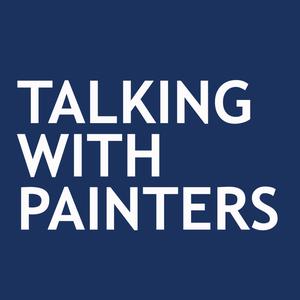
Talking with Painters
Maria Stoljar
Australian painters talk with Maria Stoljar about their lives and art
- Ep 157: Caroline Zilinsky
Podcast listeners click here to view the works
Caroline Zilinsky’s paintings freeze pivotal moments in our culture’s history, encouraging us to reflect upon our times, whether it’s the absurdity, the horror or the humour.
At the risk of being labelled a conspiracy theorist, she’s attracted to the dilemmas brought on by the internet era and shines a light on the things that trouble most of us: our loss of privacy, shortened attention, a heightened focus on appearance, a growing indifference to human suffering and the increasing power assumed by tech giants.
Her paintings often depict a political or social narrative and although she accepts some are too confronting to hang above the sofa, there’s something about the levity in her use of line, colour and form which invites us to venture into the darker corners of our culture, causing us to linger and question.
Caroline is also well known for her portraiture and landscape painting. She won the Portia Geach Memorial Award portraiture prize in 2020 (the same year she won the Evelyn Chapman award) and has been a finalist in many others including the Archibald and Darling portrait prizes.
This interview took place at the mid-career survey show of Caroline’s work ‘Exquisite Cadaver’ at the University of Newcastle Gallery. Curated by Gillean Shaw, it was a collection of 40 stunning works spanning over 2 decades. The interview was also filmed and I’ll be posting a video, including footage from the exhibition and Caroline’s studio, on the TWP YouTube channel in the coming weeks.
Feature photo: Phillip Antonio Lemos
- Caroline Zilinsky on Instagram
- Caroline Zilinsky at Nanda\Hobbs
- Sign up to the TWP newsletter
- TWP YouTube channel
- Loading Dock interview
- My AGNSW Artists in Conversation interview with Caroline
- Ceal Floyer

‘Kubla Khan’
2022
oil on linen
107 x 106.7 cm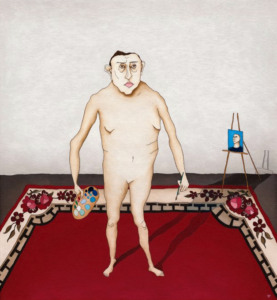
‘Exquisite Corpse’
2024
Oil on linen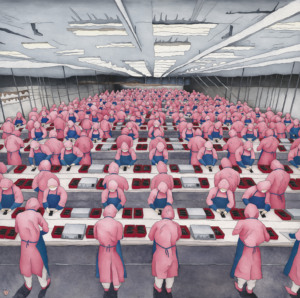
‘For Whom the Bell Tolls’ 2023
oil on linen
138 x 138cm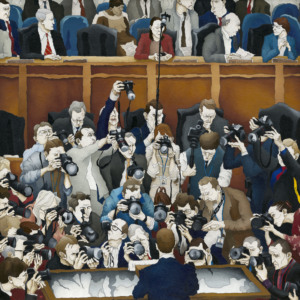
‘Faceless The Congressional Hearing of Mark Zuckerberg’ 2020
oil on linen
122 x 122cm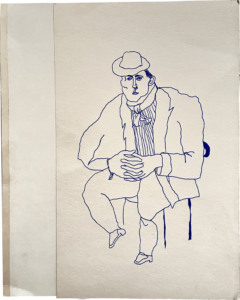
‘Man of Few Words’
2020
Ink on AGNSW archive manila folder
30 x 21cm (paper size), 60 x 47cm (framed size)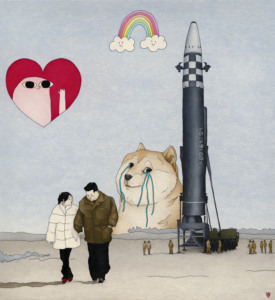
‘Somewhere Over the Rainbow’ 2023
Oil on linen
112 x 122cm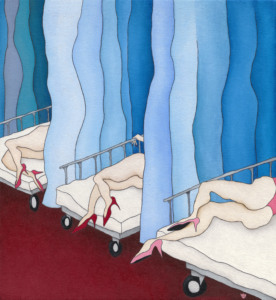
‘Plastic Fantastic’, 2023
oil on linen
56 x 62cm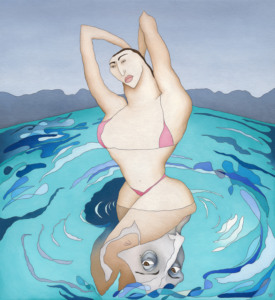
‘Refract Back’, 2023
Oil on linen
112 x122 cm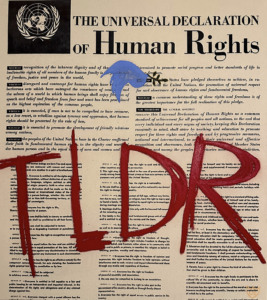
‘Too Long; Didn’t Read (Universal Declaration of Human Rights)’
2023
Oil, Oil Stick and Digital Configuration on Canvas
97 x 87cm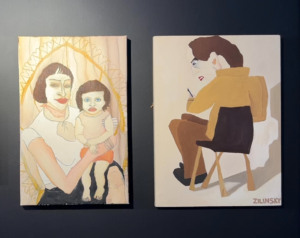
‘Me and Ellie’, 2004-2005
oil on linen
71 x 454.5cm
‘My Brother Adrian’
oil on linen
72.5 x 54cm21 April 2024, 7:32 am - The Story Behind the Painting (Part 2)
Podcast listeners click here to see images of the work
Over the years, podcast guests have shared some fascinating back stories to paintings they have made, stories which you could never have guessed just on viewing the work.
Sometimes that back story has made me look at the work in a totally different way and I’m bringing you another eight artists’ works in addition to those in ep 155.
Click on the artist’s name below for the full podcast episode (and any YouTube videos) and see images of the works we talk about below.
- Davida Allen
- Jacqui Stockdale
- Sam Leach
- Sam Leach YouTube video
- Robin Eley
- Peter O’Doherty
- Kathrin Longhurst
- Tom Carment
- Nicholas Harding
Links mentioned in this episode
- TWP YouTube channel
- Sign up for the TWP Newsletter
- TWP Loading Dock video
- NGV Triennial highlights – Instagram reel
- Memorial service for Jan Senbergs
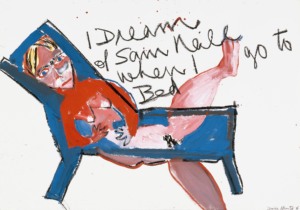
I dream of Sam Neill when I go to bed, 1986
Davida Allen
National Gallery of Victoria © Davida Allen
Collection: National Gallery of Victoria, Melbourne
Purchased 1986 (P22-1986)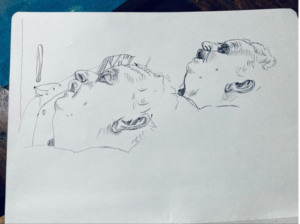
Drawings of George Stirling
Jacqui Stockdale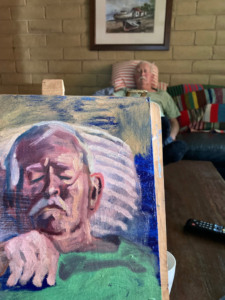
George Stirling from the Heads of the Family series
Jacqui Stockdale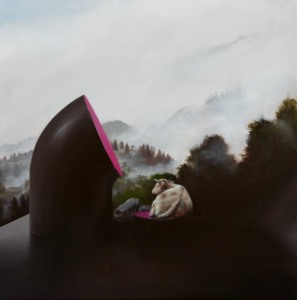
Sam Leach
Machine-assisted memory of Harewood Farm, Meadows
oil on linen
51 x 51 cm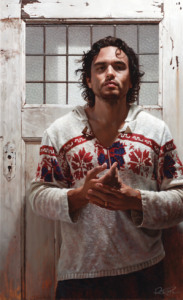
Robin Eley
‘Self Portrait’, 2010, oil on Belgian linen, 39″ x 25″
Runner Up, Doug Moran portrait Prize, 2010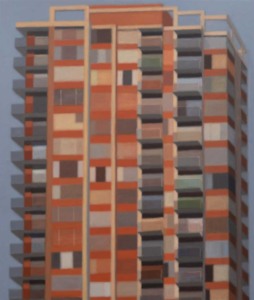
Peter O’Doherty
Edgecliff high rise, 2019, acrylic on canvas, 198x167cm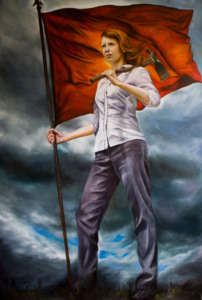
Kathrin Longhurst
Poster Girl, 2011, oil on canvas
Finalist Portia Geach Memorial Award, 2011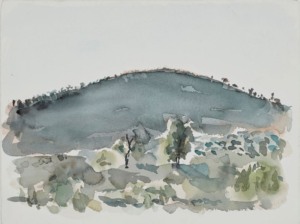
Tom Carment
Where I scattered my father’s ashes, Oratunga, SA
watercolour on paper
45.3 x 52 cm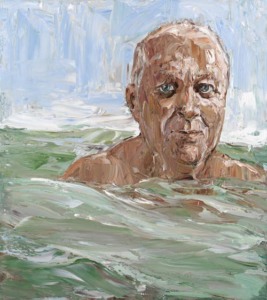
Nicholas Harding
Robert Drewe (In the swell)
2006
oil on canvas (frame: 140.4 cm x 125.0 cm, support: 138.0 cm x 123.0 cm)
Collection: National Portrait Gallery4 April 2024, 4:04 am - 25 minutes 49 secondsThe story behind the painting: Fantauzzo, Flint, Quilty and Dobell
Podcast listeners click here to see images of the works
Over the years, podcast guests have shared some fascinating back stories to paintings they have made, stories which you could never have guessed on merely viewing the work.
Sometimes that back story has made me look at the work in a totally different way and I’m bringing you a few of those to you in this episode. See images of the works we talk about below.
Links
- Tickets for talk with Caroline Zilinsky at the Art Gallery of NSW (Artists in Conversation)
- YouTube video – Anthony White
- Vincent Fantauzzo podcast episode
- Prudence Flint podcast episode
- Ben Quilty podcast episode
- Scott Bevan podcast episode on William Dobell
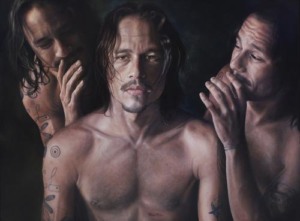
2:40 ‘Heath’, 2008, oil on canvas, 106 x 140cm (Collection of the Art Gallery of NSW, highly commended and winner of the Archibald Prize People’s Choice award 2008. Portrait of Heath Ledger)
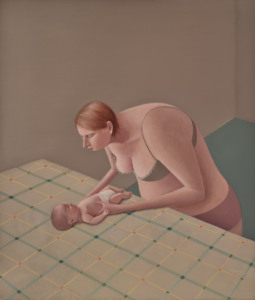
10:40 ‘Baby’, 2015, oil on linen, 105 x 90.5cm (Finalist in Archibald Portrait Prize 2015)
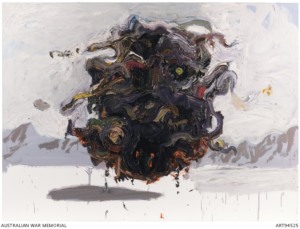
15:45. ‘Kandahar’ 2011, oil on linen, 140 x 190cm
Photo: Australian War Memorial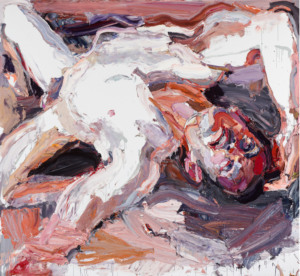
18:00 ‘Captain S. after Afghanistan’ 2012, oil on linen, 210 x 230cm
Finalist Archibald Prize 2012
Photo: AGNSW/ Mim Stirling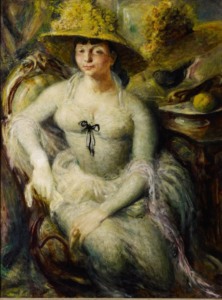
20:30 ‘Margaret Olley’, 1948, oil on hardboard, 114.3 x 85.7 cm board
Collection: Art Gallery of NSW
Winner Archibald Prize 1948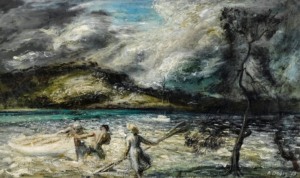
23:45. ‘Storm Approaching, Wangi’, 1948, oil on cardboard on composition board, 32.9 x 56cm
Winner Wynne Prize 194819 February 2024, 2:04 am - 34 minutes 17 secondsInspiration from the archives | The Flow State
Podcast guests talk with me about the flow state!
See below for timestamps and links to each guest’s full podcast interview and video
3:39 Julie Nicholson and Fiona Verity – Podcast | Instagram video
6:40 Ann Thomson – Podcast | YouTube
7:54 Joshua Yeldham – Podcast | YouTube
10:15 Antonia Perricone Mrljak – Podcast | YouTube
11:25 Wendy Sharpe – Podcast | YouTube
12:51 Lewis Miller – Podcast | YouTube
13:50 Aida Tomescu – Podcast | YouTube
16:30 David Griggs – Podcast | YouTube
17:27 Idris Murphy – Podcast | YouTube
18:40 Kathrin Longhurst – Podcast | YouTube
20:50 Anthony White – Podcast | YouTube (coming soon)
22:07 Bernard Ollis – Podcast | YouTube
23:59 Kim Leutwyler – Podcast | YouTube
25:20 Tim Maguire – Podcast | YouTube
26:40 Belinda Street – Podcast | YouTube
27:58 Yvette Coppersmith – Podcast | YouTube (coming soon)
29:30 Tim Storrier – Podcast | YouTube
31:15 Jacqui Stockdale – Podcast | YouTube
32:02 Sandi Hester – YouTube
Links
Sandi Hester interview on the YouTube channel
Sandi Hester’s YouTube channel ‘Bits of an Artist’s life’
TWP Instagram reels – ‘Summer reels from the archives’
Ep ‘Inspiration from the archives: Colour (1)’
Ep ‘Inspiration from the archives: Colour (2)’23 January 2024, 10:12 pm - 6 minutes 9 secondsEp 153: Jan Senbergs
Above photo of Jan Senbergs by Riste Andrievski
Click play for my podcast introduction to this interview and scroll down for the transcript.
Podcast listeners click here and scroll down for transcript.
Watch the YouTube video of Jan Senbergs’ studio and work here
Links
- Jan Senbergs’ website
- Jan Senbergs on Instagram
- Jan Senbergs at Niagara Galleries
- Talking with Painters YouTube channel
- Talking with Painters on Instagram
- Talking with Painters on Facebook
- Subscribe to the TWP newsletter
- PDF version of transcript for tablet/desktop
With over six decades of work as a painter, printmaker and draughtsman, leading artist Jan Senbergs has exhibited in over 50 solo shows and has been the subject of three survey shows including a major retrospective curated by the National Gallery of Victoria in 2016. A rare accomplishment.
His art evolved from early masterly screenprints to large scale paintings and with subject matter as varied as urban and natural landscapes, industrial themes, surreal structures and forms and aerial map-like works.
This episode has been a long time coming. Covid threw out our plans for an early 2020 meeting but two years later we met in Jan’s inspirational studio in Melbourne. His voice has been affected by some health issues and so this episode is coming to you by way of transcript (below) and an intro on the podcast.
As I was setting up my audio equipment on the day of the interview, Jan and I chatted about the time he had spent in London in his 20s. We talked about other Australian artists who were there at that time. That’s where the recording of the interview began.
Jan Senbergs
I was the younger artist who came into that area and I didn’t know anybody. I didn’t want to bother the local Antipodeans (laughs) so I usually went out by myself. I headed for the National Gallery on one occasion and ran into Arthur Boyd heading there too. We travelled together on the bus from Pimlico to Trafalgar Square. It was very nice because we walked through the Gallery making comments. It’s lovely to do that with another painter. We walked past one room and Arthur stopped and said, ‘There’s a good painting in this room.’ It was a big dog watching over a dying nymph, by Piero di Cosimo. He was such an interesting painter. Afterwards, Arthur suggested we go and have a drink, so we went across the road and had a couple of beers and then he said ‘You’ll have to excuse me, but I’ve got to go back home. I’ve got a few duties there.’ We shook hands and I never saw him again.
Maria Stoljar
You never saw him again?
JS
No, but what was nice about it was the generosity of the older person to somebody younger who had just arrived.
MS
How lovely. But you knew a lot of famous Australian artists like Fred Williams, for example. He was a friend of yours, wasn’t he?
JS
Yeah, I knew Fred. When I first started showing around, I mixed with some of the older artists. At that time there were hardly any younger artists around. And because I hadn’t gone to an art school, I was very isolated. It’s quite different for artists today. Now there are thousands of young people trying very hard to make good art after their schooling. It’s a different atmosphere. Schools pump out all these people with hopes and ambitions. That’s the reason it’s good to know some of the older painters.
MS
Yes. Like John Brack?
JS
Yes, John Brack was one … Len Crawford, Fred, Roger Kemp – these were heavy-duty Melbourne blokes.
MS
It’s amazing that you, in your early 20s, were hanging out with those people.
JS
Yeah, it was actually. Because I couldn’t get into art school so I’d started working in a silkscreen printing company, which was a terrible bloody job (laughs).
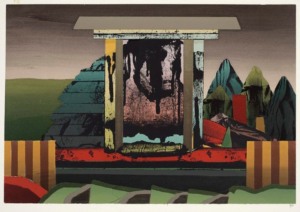
‘Modern monument in colour ‘ 1975,
Colour screenprint, 56.6 x 81.2cm (image)
National Gallery of Victoria, MelbourneMS
Why? Was it heavy work or just dirty work?
JS
Dirty work. Screenprinting was very dirty. It was toxic and unventilated. As an apprentice you’ve got to scrub the screen and so on – you get all the shit jobs (laughs), but that’s understandable.
On Friday nights, though, during the period of the six o’clock closing, I used to go into town. I didn’t want to go with the local trades blokes and drink with them, I’d go straight into Little Collins Street where all the real old lefties hung out – a fantastic atmosphere. They weren’t all painters by any means – there were writers, clapped-out academics and all sorts of people.
MS
Really bohemian.
JS
Yeah, but interesting to me. I went there and I just stood around. They didn’t pay any attention to me, but I was listening. It was an education. A political education as well.
MS
How amazing. So did you keep in contact with those people?
JS
Well, most of them I did, yeah. Including some writers. I was always interested in writing and writers. I used to read a lot when I was younger. The usual standard fare of James Joyce (both laugh).
So I was mixing with all these people at six o’clock closing. There was a frantic atmosphere on a Friday night. There were all these characters coming in from work, and they wanted to have debates and bash out the things that they wanted to talk about. It was interesting.
MS
Yeah, and do you feel like that sort of political leaning comes through in your painting? Do you consciously think about that?
JS
No. I mean, it’s there. How can I put it? I don’t like to be a spruiker for any cause. Your paintings should do that. Usually what happens is that if people are too strident in their political views, they produce paintings which are very single-minded – with a message they want to send, but often the artworks are no good. There’s always been a debate about that, to see how far you can go.
MS
Actually what comes to mind are the ‘Altered Parliament House’ works. Those two works you painted when you were in Canberra. You were there during the dismissal of the Whitlam government in 1975. They’re powerful paintings which are silkscreen and oil. Can you tell me a bit about that time?
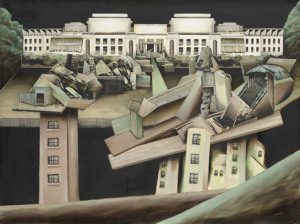
‘Altered Parliament House I’ (1976) Synthetic polymer paint and oil screenprint on canvas Collection: National Gallery of Victoria
JS
I was in Canberra at the ANU for a couple of years. What do they call it? Creative Arts Fellowship. They gave me a studio. Students were supposed to come and listen to your wise words but nobody turned up so it was a very easy job (laughs). And a very interesting period because at that time the Whitlam Government was introducing Medicare. I used to go to Parliament House and sit listening to Question Time. I’d wander up there out of curiosity, to see what they were talking about – to see how they were misbehaving (laughs). It was fascinating, it was lively. Then the day came when Gough was overthrown. The two paintings I did were of Parliament House (the Old Parliament House). They were sort of on a dark ground. It was nighttime. I was living in Campbell which crossed Anzac Parade and in the distance you could see this white ghost-like structure that was Parliament House. It gradually became a kind of symbol, or the anchor, for the paintings. They’re about as close as I’ve ever been to a political painting – I like to leave that sort of thing with a suggestion rather than hammering it down somebody’s throat.
MS
I think one is in the National Gallery of Victoria and the other is in the National Gallery in Canberra. With respect to number one, in the foreground there are ruins and so it’s like a metaphor for the destruction of the whole parliament in a way?
JS
Yeah, it did have those suggestions. Everybody was very keen on what was happening politically at the time and so you didn’t need to sort of push your point. Politically, I’ve been towards the left all the time, but at the same time I’m very critical and I’m becoming more critical as I get older! (laughs)
MS
What I find interesting about your work is the fact that you started off in silkscreen printing and even though you let that go by about 1980 or so, you started incorporating that into your painting.
JS
That’s true, yeah.
MS
That sounds like a quite laborious thing to do.
JS
It was a shocking thing. I hated it by the end of it. (laughs)
MS
(laughs) Did you? Why?
JS
Oh, it was so laborious to get things right, setting up the registration over large areas. It was very hard work. It wasn’t like when you’re painting or doing a drawing. When I came back from Canberra, I was doing screen prints and I felt at that stage that I was getting a bit too sophisticated with the prints – too much of a smartarse (laughs) – so I gave it away.
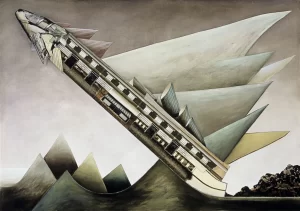
‘The flyer’ 1975
Synthetic polymer paint, oil screenprint on canvas, 167 x 244cm
Collection of Paul Guest, MelbourneMS
I think by that time you were being called ‘the greatest silkscreen printer in Australia’. Maybe that was when you felt like you had had enough?
JS
Well, I don’t know about that. But what I wanted to do was to make a mark again, go completely the other way. So I began to draw. And I started to draw around Port Melbourne, especially old Port Melbourne. I gradually changed.
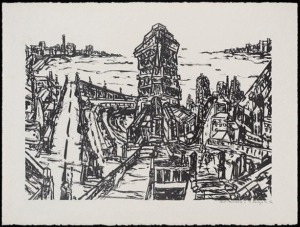
Port panorama, 1980, lithograph, printed in black ink on white BFK Rives Moulin du Gué paper
45.4 x 63.4 cm image; 57.0 x 76.0 cm sheet
Collection: Art Gallery of NSWMS
So that was quite an industrial sort of landscape?
JS
Yes. And that was also around the time that I met my second wife Helen Beresford.
MS
Yeah.
JS
All of these things – it was a very exciting time.
MS
It must have been a really big change in your life.
JS
It sure was, yeah.
MS
And it was around that time that you got that huge commission to create a work for the High Court of Australia. I think you were involved from the very beginning when they were designing that building. Just to give a bit of background – the High Court of Australia is a great example of brutalist architecture. We’re talking about huge concrete walls, big open spaces, and the area that you had to create a work for was quite a large area.
JS
In the atrium, yeah.
MS
So how did you go about that?
JS
They had a shortlist of about four or five when they gave me the job. I think they probably gave it to me because I’d realised it was too huge an area for canvas – it would sag within a couple of years – so I’d thought of some other material. I started through theYellow Pages to look for materials. I didn’t get very far! I spotted ‘aluminium’. That was it! (laughs) Aluminium was light and it was permanent, you had to anodise it, it wouldn’t corrode.
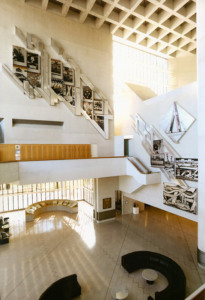
Constitutional Wall Mural and States Wall Mural 1977 – 80
Collection of the High Court of AustraliaMS
Had you ever used it before?
JS
No
MS
So this was a totally new technique that you were going to try?
JS
That’s right. I had a friend, Ian Claremont, who knew about anodising. It was all a bit unexpected. I told the story of the Constitution of the High Court, the States and the Supreme Court with images etched into the aluminium.
MS
So the brief was basically to depict imagery about the Commonwealth and the six states. Is that right?
JS
They didn’t mention the six states but that became part of it. I introduced that.
When I first got the job, I knew nothing about the High Court and I wondered ‘What the hell am I going to do? What sort of design?’
MS
(both laugh) Well, I think before the building was built, the High Court was sitting in Melbourne and Sydney. There was no building in Canberra?
JS
That’s right. The High Court had rooms in every state – small rooms, chambers. In order to find out more about what the function of the court was, I was lucky enough to meet Ninian Stephen, who used to be the Governor-General and a High Court Judge. I asked him if I could come and see him to explain what the functions of the High Court were.
MS
(both laugh) Well, I mean, when you think about it, the layman wouldn’t know what the High Court did.
JS
Ninian Stephen was so tolerant and kind to me. He carefully explained how the High Court worked. Then I had to design it. The logistics alone were a challenge. I was worried the whole thing would slide off the wall – so I designed these boxes and I screen printed images on them. There was the Constitutional wall and the States wall, shooting all the way up to the top.
MS
And how did you come up with the imagery? What were you looking at?
JS
Well, by that time I was looking at various symbols of Australian institutions. In the case of what I call the States wall, I had all sorts of symbols from each state. For example, Queensland had a tropical industry, sugar cane, which told a story. The larger Constitutional wall was to do with things from the time of Federation when Australia became a state in its own way – a changeover from the British way – so there are a lot of images there. And they liked it (laughs). I found an anodising factory in Melbourne. When it finished for the day, Ian and I would go there through the night and etch the big aluminium sheets in huge acid baths before the factory began its morning shift.
MS
It’s fantastic and it’s still there, obviously. And I think the Queen came when they opened the High Court, and didn’t you have an exchange with her?
JS
I did, actually. When we finished the job and the time came to open it, we were all lined up and the Queen and Prince Philip came along, with the Chief Justice Garfield Barwick introducing us. When the Queen got to me she looked up at my piece and she said, ‘My, that’s big.’ I said, ‘Yes, Ma’am’. The Duke was about four paces behind, and he came up and said, ‘Do you do this kind of thing often?’ and I said ‘Whenever I can’ (laughs). So that was my meeting with the Queen and the Duke.
MS
(laughs) That is a pretty amazing story. So let’s talk about other works of yours that I’ve found interesting. And one of them was when you went to Antarctica. What was that trip like?
JS
It was marvellous, wonderful. It was back in 1987. We went down with the Australian Antarctic Division’s resupply ship MV Icebird. It sailed out to Heard Island and delivered food and supplies to the Davis and Mawson stations. That was the main intention of the trip. It was marvellous too on all sorts of levels. The Antarctic landscape is fantastic and it’s been photographed a million times, but my angle was a bit different. I was fascinated with life down there and how we are squatting on another continent with our suburban values. My paintings were more about the bases than the icebergs.
MS
And you had two major paintings, ‘Mawson’ and ‘Davis’, depicting those bases down there where you gave us that aerial perspective that you’re very well known for – those map-like paintings. These aren’t the same as your more urban pictures but it’s that sort of feel, of an aerial perspective. And with all that ice in the background, these are very dramatic paintings.
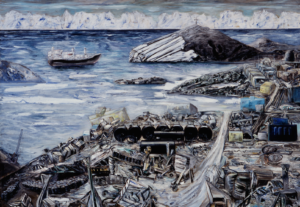
‘Davis’ 1987
Synthetic polymer paint on canvas
213 x 289cm, private collection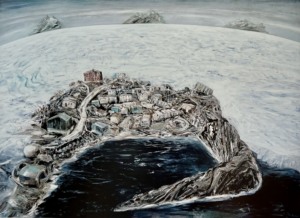
‘Mawson’ 1987
Synthetic polymer paint on canvas
213 x 289cm, private collectionJS
Yes, the ‘Mawson’ painting is like that. You’ve got this settlement right on the edge with a huge dome of Antarctica behind it. I exaggerated it. There was a kind of map-like painting of a base as well as a huge amount of rubbish lying about. Part of the job was to pick up some of the rubbish and go and put it back on the ship and take it to a quarry in Tasmania.
MS
Oh ok, I didn’t realise that. That’s interesting because that idea of detritus and waste, that’s something that often appears in your work. Is that something that attracts you – those forms?
JS
I start off with images that I want to use. Then I apply some of them to paintings. It’s a combination of thinking. It’s hard to explain. It’s a kind of storytelling, only in a less obvious way. Firstly, I paint a quality of imagery, before I start telling the story–you know, that’s important. With Davis and Mawson, I wanted details of various things that I wanted to add to the composition – a bit like early Chinese landscapes that are taken from various levels – unlike the Western view on a fixed level. So you have various points of viewing all crisscrossing that make up the composition which you in turn take to the next step to make it interesting.
MS
Yeah. Would you start with a sketch to determine the composition?
JS
Yes. But also I had notebooks. I’d do sketches there. They were mostly sketches from memory. Plein air ones as well of course.
MS
And when you’re working on a big painting, do you ever decide halfway through ‘this isn’t working, I’ve got to change it’. Does that happen often, or have you really predetermined it before you start?
JS
You mean the composition?
MS
Yes.
JS
Sometimes. Sometimes you fail and you start from scratch again. But not often. For me, a lot of these canvases are like maps. I’d worked out the scale, the relationships. There’s a lot of fiddling around with map-like imagery early on.
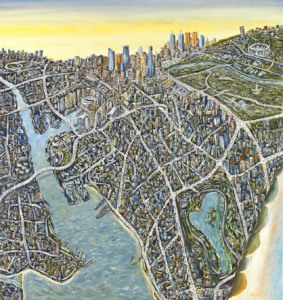
‘Melbourne capriccio 3’ (2009)
Synthetic polymer paint on canvas, 195.2 x 184cm
Collection: National Gallery of Victoria, MelbourneMS
I’d like to jump back now – so in 1966 you were awarded the Helena Rubinstein Travelling Art Scholarship and you went to Europe. You stayed in London for a while and then when you came back in the late 1960s, things had changed in the art world hadn’t they?
JS
They sure had, yeah.
MS
Can you tell me a bit about that? I think all the rage was colour field painting, hard edge abstraction …
JS
That’s right. When I came back there was this new type of thing here and so I wanted to show some of the smart tricks I learnt in London (laughs)
MS
(laughs) So, you found that you changed direction a little bit over that period?
JS
Yeah, I realised that my previous paintings were too clogged up, too rich sometimes, and also crude. I didn’t mind the crudeness but it was time to leave that. I’d grown up a bit (laughs). I made some steel sculptures, a kind of gesture at outdoor art, minimal art.
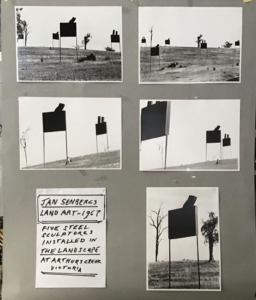
MS
They were quite geometric, weren’t they?
JS
Yes, standing on legs. They were about 20 feet tall. I made them in my backyard. I left the final processes to the fabricator but I made the design, a kind of slot to hold this image of a head, but the problem was the image was too top heavy (laughs).
MS
So they didn’t stay up?
JS
They stayed up for a couple of years, in St Andrews, in the hills north of Melbourne. I found some land to put this stuff on and met Cliff Pugh, who lived up there. He said I should contact Frank Dalby Davison. Dalby Davison was a very controversial and interesting writer in the ’30s, being ahead of the game and writing about people’s relationships. He agreed to put them up on his land, and I said I’d try not to make a mess (both laugh). I made five of these sculptures and dug a ditch and put them in concrete and left them there. You could see them from the road down below the hill and people were wondering what the hell they were.
MS
They looked sort of alien?
JS
Yeah, some people thought they were guideposts for planes coming in. People came up with all sorts of explanations for them.
MS
Isn’t that the definition of great art? To get people to wonder and to use their imagination.
JS
Exactly, yeah, that’s right. They stood up there for a while and then one day there was a huge storm and they blew over. Also, the cows didn’t help. Frank Dalby Davison had a lot of cows and they were leaning against the sculptures, causing them to topple, and I thought that was very unfair for Frank (both laugh).
MS
That’s a shame, but at least you’ve got images of them.
JS
Yes. I went back and saw Frank and said, ‘You’ve been very generous’.
MS
I bet he missed them because they would have been like a real statement on his property.
JS
Well, it could have been that. I suppose I was one of the first people doing that sort of thing in Australia. The Americans did that sort of land art– Robert Smithson and a couple of others, but in different ways. I had always wanted to do something outside of painting.
MS
And 3D obviously as well. But you didn’t continue to do a lot more of that sort of sculptural work?
JS
No, I stuck with the brushes.
MS
I want to take you back to when you first got to Australia. You had a rough time during the war years. What was it like when you got here?
JS
We left Latvia, ending up in the British sector after the war, in a DP (Displaced Persons) camp. We stayed there for about four or five years. And finally, we got boats to Australia. Nobody knew anything about Australia. For example, my grandmother who was with us carried a ham that she’d cured because she thought that in Australia there’d be no food (laughs). When she got off the ship the Customs officers took the ham. She was so upset – ‘They’ve taken away my food!’ (laughs). We were hauled off to Bonegilla, the migrant camp near Albury-Wodonga. It was an old army camp. All the adults were moaning and groaning but us kids loved it. I’d just turned 10 so I was very happy. It was like we were released from some dark place to this wonderful sky and golden grass, to muck around and enjoy all of it.
MS
So it was a very optimistic experience coming to Australia for you. You couldn’t speak English at that point?
JS
No. We lived there for about four months – my sister, mother, grandmother and I. The camp had people from all sorts of countries. We went to a one-teacher primary school for young farming kids – there were only about eight students. I often wonder how the local kids must have felt – their lovely little school invaded by hundreds of little wogs! (laughs)
MS
(laughs) What experience did you have with art at that point? How did you become interested in art?
JS
I was always drawing as a child. I went to trade school in Melbourne, at Richmond Tech – but I wasn’t at all interested in trades. I started to do little sketches in my exercise book. One day Len French the painter came to the school as a rookie teacher. He was a terrible teacher (laughs), but he used to liven the place up. One day he brought in three postcards: One was of saints, by El Greco, one was Cezanne’s ‘Mont Sainte-Victoire’, and the third was ‘The Sleeping Gypsy’ by Henri Rousseau. Len said, ‘Which one do you like?’. I liked Rousseau’s Sleeping Gypsy. And that triggered something in me because I began to realise that there was this other big world out there.
MS
He must have been a very exciting person to come into your life.
JS
He was, yeah.
MS
Was he an established painter at that point?
JS
No, he wasn’t. He was becoming established – he ran with the local scene. A couple of years before that he’d been overseas, he’d done a bit of travel, so he was sort of sophisticated.
MS
And he became a mentor for you for many years?
JS
He was in a way. He introduced me to the pubs (both laugh).
MS
Is that how you got to meet John Brack and Fred Williams and the other artists in Melbourne?
JS
The way I met John Brack was different. I had a studio in Hardware Lane – one of the lanes of Melbourne. It was an awful place, very dark and dingy, and I was doing these black, ugly pictures that nobody could possibly want (laughs). One day in walked John Brack with a bloke called Hal Hattam. He was a doctor who hung around with the artists and was a bit of a collector as well. Brack was very austere and firm, and I was like a rat scurrying around. They didn’t say much, just looked around and then left. But about two weeks later I was asked to drop a painting off at John Brack’s house – he’d bought one of my paintings. I was so touched.
MS
Wow.
JS
Because coming from him it was so special.
MS
Yes, and that’s before you actually got to know him?
JS
Yeah, he liked my stuff.
MS
He was a lot older than you, like 20 years older?
JS
He was, yeah. He came out of the army without firing a shot and then he became a teacher in Melbourne and got a job at the Gallery School at the NGV. He ended up teaching at Melbourne Grammar – all the little rich boys. (laughs)
MS
Well, they have to be taught too (both laugh).
JS
John Brack was a big influence on me because he was the conscience of our generation. Later, we shared the same dealer, Rudy Komon, who was my dealer in Sydney. George Baldessin was also with Rudy. As was Fred Williams. A bit of a boys’ club.
MS
Well, I suppose in those days there were fewer women artists. But that must have been a pretty amazing thing for you because Rudy Komon was one of the most influential art dealers in Australia at the time. He got you on his books when you were in your mid 20s I think?
JS
Yes, I was.
MS
That’s amazing.
JS
He was planning to give me a first show. But I’d gone and made a mess of myself – I sort of spoiled it all – I smashed myself up in a car accident. Went through the windscreen and almost lost an eye. Rudy came into the hospital and saw me and as he walked out, he said to someone, ‘Well it’s a pity about Jan, he could have been a good artist’ (laughs), and I said ‘Don’t say that!’
MS
I can imagine you didn’t want to hear that at that time. That didn’t happen in the end, thankfully!
JS
Years later when Rudy and I travelled around the place I sometimes raised that: I said, ‘Rudy, you almost wrote me off – you told me I was no good!’ He said ‘Oh, I wouldn’t do that to you.’
MS
So, you were with him for 20 years or so?
JS
Close to it yeah. He was quite different from the other dealers. He gave money to various painters from his stable.
MS
Like a wage sort of thing?
JS
Yeah, to keep them going. Rudy also had Jon Molvig from Queensland. Molvig would ring up Rudy and say, ‘Rudy I need some dough- not just some dough – the full symphony’. He was very keen on Molvig.
MS
And Rudy had a lot in common with you, didn’t he? Because he was also a migrant.
JS
He was, yeah. Though he never talked much about his past.
MS
He was a lot older than you.
JS
Oh, yeah. He was an interesting character. The first time I showed with him was in the ’70s. I was in a drawing show. When I came in from Melbourne to the gallery and saw red stickers everywhere. I said, ‘Rudy, Jesus! You mean all these people bought my drawings?’ and he said, ‘Oh yes, Jan, there are a few people who like you.’ But who they were he wouldn’t say. Years later, after he died, I was at Rudy’s gallery with Gwen Frolich. She was Rudy’s rock. She’d pulled him out of problems time after time – tax problems and all the other stuff – and she and I were looking through Rudy’s storeroom. We were digging through all this stuff when I came across one of my drawings. Then I found more of them, all from that first drawing show. And I said to Gwen, ‘What’s the story?’ Gwen just smiled and drew on a cigarette. She said, ‘Rudy thought you needed some money at the time.’ Rudy had bought up my drawings!
MS
And he did it that way so that it bolstered your confidence as well.
JS
Yeah, he was a good bloke. But he was full of bullshit as well (both laugh).
MS
Well, anyone in the art world has to be a bit like that don’t they?
JS
Yeah. I once travelled with him to South America, to the Sao Paulo Biennial, in which I was representing Australia. We went on this trip with James Gleeson.
MS
The famous surrealist painter.
JS
Yes, that’s right. Gleeson’s partner, Frank O’Keefe, wanted to go as well so it ended up being the four of us on a plane to Brazil, via Tahiti. Rudy wanted to go as our representative, but he really just wanted to be there for the trip.
MS
So for that 1973 Sao Paulo Biennial I understand you did 18 large paintings over two years. Those works were very typical of what you were doing at the time, those bleak industrial landscapes, very large works?
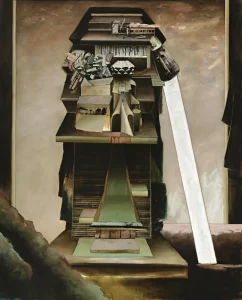
Fort 2 (1973),
152 x 183cm synthetic polymer paint, oil screenprint on canvas
Collection: National Gallery of Australia, CanberraJS
Yes, that’s right.
MS
And I think Fred Williams called you an ‘industrial surrealist’.
JS
(laughs) Yeah.
MS
Those structures and forms that are in those paintings – for example, ‘Fort 2’ – they do have quite a surreal quality to them. They don’t exist in the world. How did you come to paint those images?
JS
I was just starting to use silkscreen techniques in a painting, which straight away made everything much sharper. Even though you might have very dark colours, blacks and browns, there’s movement within those colours. People picked up on an industrial theme. People have sort of pigeonholed me as an industrial landscape artist. I’m not just that, I’m a lot of other things at the same time. But they like to label you – it’s always the case.
MS
Yeah. For example, those Antarctic paintings are totally different. Actually, those works where you were painting near your holiday home around the Otway Ranges in south-western Victoria, they’re also really beautiful works, and very expressive paintings.
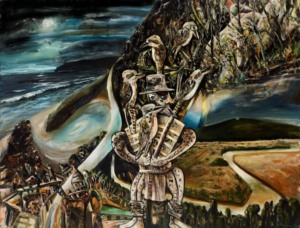
‘Otway night’ 1994
Synthetic polymer paint on canvas, 198 x 259cm
Collection: Art Gallery of NSW, SydneyJS
I’m glad you like them.
MS
And you know what I noticed about those and also the map paintings, those aerial paintings – they have much more colour. Did you find that you were using more colour later in your career?
JS
Yeah, I think so. I was slowly moving away from what I call my ‘axle grease’ period.
MS
(laughs) Which I liked as well.
JS
But you’re right. The colour change is there in the Otway paintings. It’s not over the top, but it’s there. I suppose as you get older you don’t have to hammer everything every time. You learn how to just step back, to retain your point. When you’re younger you’re fierce and attacking. As you get older it doesn’t matter so much. I’m finding that with me these days. I’ve had a very good run when I come to think of it – all the things that I’ve had the opportunity to do. It’s been marvellous. I’ve had the chance to do my own imagery, and I have always wanted to be outside the main movement. Maybe close to the movement sometimes, but not part of it.
MS
Why do you think that is?
JS
Must be my twisted nature (laughs).
MS
Yeah, well, I’m going to be a psychoanalyst now. Is it partly due to coming to Australia when you were 10, and not going to art school, not doing the traditional thing that somebody who was born here might have done?
JS
Yeah, sure. You become very aware of that of course, but you still want to follow your own path. I never wanted to copy anybody’s work. You always try for some kind of originality, even if it isn’t possible. That’s what I’ve always thought.
MS
Your subject matter is really interesting, and the ways in which you find inspiration, for want of a better word. For example, in the Otways works, the William Buckley theme came through; the outsider, the escaped convict who lived among the Indigenous locals. It must be pretty exciting when you come across a theme or subject that really draws you?
JS
Yes, it is. Sometimes it takes a long while to realise that but you’re right – it’s very much about retaining your ‘handwriting’ — I always tried to do that.
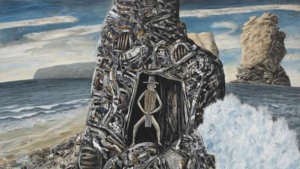
‘Buckley’s Cave’ 1996
Collection: Geelong GalleryMS
Well, I suppose you can’t paint any other way. You’ll always end up painting like yourself.
JS
That’s right. When I did a series of paintings, whether they were from Antarctica, or Mount Lowell in Tasmania, or some of the other places, I always had a father figure.
For Mount Lyell I had Robert Sticht, who was chief metallurgist in Queenstown in the late 1890s. He was a very eccentric character. A mining boss, but also quite sophisticated. He was a man of some culture. He had a Rembrandt print and a priceless private library. I’ve always been attracted to characters like that.
There were two people from the Antarctic. One was Carsten Borchgrevink. He was a schoolteacher in country New South Wales at the turn of the century. But he was also a bloke who wanted to go down to the Antarctic. He ended up getting on a whaling boat as a sailor, bound for Antarctica. At this point no one had set foot on Antarctica – a lot of people had come close. When Borchgrevink who was rowing a boat with an advance party realised he was coming close to the land, he jumped out and said, ‘I’m the first human being to put foot on Antarctica’. His captain pulled him back straight away, but Borchgrevink was a hero. He was a difficult man, very awkward, but he had this madness about him which I found very attractive.
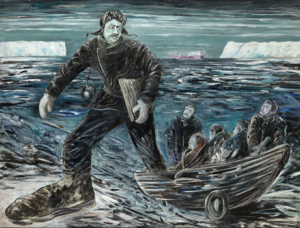
Borchgrevink’s foot (1987)
Synthetic polymer paint on canvas , 197 x 156cmAfter that first trip, he gathered a team together and went down to the Cape Adare area. They stayed there for a year, so he was among the first to stay for an extended time as well. He was a real outsider. I’ve always loved mavericks like that. Despite Borchgrevink’s success, the British ignored him completely because he wasn’t part of the Establishment, not part of the Royal Scientific Society and all that, he was just a loose cannon. But before that he beat Scott to the South Pole. He also stayed with Amundsen. In retirement Borchgrevink was finally given some sort of recognition, the British Royal Society medal – bugger all, really!
I got a sense of what inspired Borchgrevink when I went to Antarctica myself. A couple of helicopters used to drop us off right in the middle somewhere, in the most remote expanse. And you sat there in the evening with a glass of whisky in your hand, thinking, ‘I’m really away from the world’, that sort of feeling.
MS
Amazing. I imagine the stars were really bright.
JS
That’s right – and also the southern lights, Aurora Australis. At 10 o’clock one night on the Icebird we were all down in the hold drinking and I went on the deck just to get away from all that – and I saw this massive white yellow streak going right across the sky, like a big question mark. The others came out and we stood around in awe.
MS
You know one of the paintings I liked from Antarctica was the one where your fellow artist Bea Maddock is being lifted onto the boat. She’d broken her leg and you painted her being winched aboard?
JS
Yes, poor Bea. She’d barely made it to shore when she slipped. For the rest of the trip she could only sketch from the boat.
MS
That would have been pretty rough being on a boat for weeks not being able to move around.
JS
Yeah, she was very stoic. The isolation was tough even without an injury like that. This was back in the days with the old radio systems – no phones, so to make contact with your family or anyone else you had to book in and you could talk for 10 minutes on the bridge and that was it.
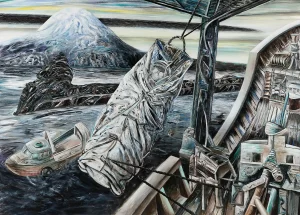
‘Bea Maddock being lifted onto the Icebird- Heard Island’ 1987
Collection: State Art Collection, Art Gallery of Western Australia, PerthMS
So you would have really felt cut off from the rest of the world just on this solitary ship. And back home, as far as your regular routine goes, have you always worked five days a week or does that vary?
JS
Probably five days a week. On Saturdays I could be found sort of floating around the house, or maybe having a punt on the horses or watching a bit of footy. I’m very ordinary! (laughs)
MS
(laughs) I don’t know if ‘ordinary’ is the right word, Jan. When I look around this studio and see how much work you’ve done over the years the thing that strikes me is that you have created so many huge works over your life. You didn’t muck around. You had an idea and you executed it.
JS
Yeah, that’s generally true.
MS
I suppose using acrylics is quite good for that?
JS
Yes, acrylics are good for large-scale painting. When I was doing some smaller work I’d use oil. But what I found was that I’d use acrylics so close to oil that people don’t know.
MS
Let’s talk about work you’ve done more recently. When I was supposed to first see you two years ago, before COVID intervened, your show with Niagara Galleries was on, called ‘Not Quite the Last Picture Show’ . You had a self-portrait in that and I thought, wow, I hadn’t seen a lot of self-portraits by you. Although, speaking to your wife Helen, she said that you actually do self-portraits from time to time.
JS
In secret (laughs).
MS
Well, I thought that one in the show was great. It was called ‘Floating’ and it was basically a head disembodied – there was no neck even.
JS
That’s right. That was the intention.
MS
Can you tell me about that?
JS
It was because I wanted some sort of figurative element for the show. I was hoping to do a bigger one but then when I did it I thought, ‘That’s enough.’ I’ve done other self-portrait drawings and so on, but portrait painting is another thing, a special thing.
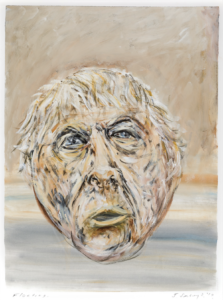
‘Floating’ 2019
Acrylic on paper, 68.5 x 51cmMS
Do you like it?
JS
I like it, yeah. There are some good portrait painters – people like Rick Amor, fantastic painter. There are quite a few in Melbourne.
MS
Yeah, Rick Amor is amazing.
JS
But the thing is with the art scene there’s a lot of intellect – the new way of making art. You get all these sort of sharply designed things, bold colours and everything else, but at the same time I think they have a limited life. The photographic image is good, but I think painting is better, though it depends what the painting depicts. Every week when you read the reviews – not that there’s many reviews anymore – you see the fascination with a method, a technique, and not enough of what it’s actually saying.
I always thought that anything is valid providing you’re not overcome by the wonderment of technique. I still believe you can be very avant garde just being a painter. Just painting. It’s your life in a way. It’s done by hand.
MS
Totally. It’s becoming more and more valuable and valued because we are bombarded by so many digital images and photographic images that this idea of putting paint on a surface, it’s becoming more rare.
JS
That’s right. When you’re growing up you’re learning all about art, modern art and so on, it’s all part of it, but at the same time you’re always looking for some odd character that’s coming up.
MS
You’ve held lots of very important positions over the years. We talked about your position at ANU. You were also appointed visiting chair in Australian studies at Harvard University, which was I think the first time an artist was appointed to that position. And you were a trustee of the National Gallery Victoria. You’ve been bestowed the highest award at RMIT, the Doctor of Arts, and you’re one of the leading artists in Australia. Yet you’re so modest, Jan. How have you been able to keep your feet on the ground over all these years?
JS
Well, I don’t know about modest. The thing is you do these things – and I’ve never asked for this to happen – people just gave them to you. Harvard, for instance, there was never an artist in that position, it was always high-class academics. I’d never been to university and here I was going to the top university in the world! (laughs)
MS
(laughs) What was that experience like?
JS
Marvellous, but tough. The students at those universities are very, very eager and I found myself doing quite a lot of talks on Australian art. When I went there I thought, ‘What the hell have I got to do here?’ and then Harvard said, ‘Jan, could you arrange an Australian art show?’ So I started asking around about borrowing all sorts of art. It was all going to take so long. Then when it all looked impossible we got the Holmes a Court collection, a very distinguished collection of Aboriginal art from various parts of Australia. And that was part of my mission – to show Australian art.
MS
You were saying to me before that you’re probably not going to return to painting at this stage. Have you decided definitely?
JS
Well, it’s rather hard for me, having this ailment, it’s harder to set up.
MS
Are you still drawing?
JS
Yeah, I’m doing some drawing. But you see I’m at the end of things – this is my studio, this is the place I built over the years. I mean, (my wife) Helen and my daughter Jes are doing a great job cataloguing my stuff, but it’s not a working studio anymore.
MS
It’s a pretty special space. I’ve seen a lot of studios over the years since I’ve started this podcast. And I’ve got to say this one is probably in the top three, if not number one – it’s just wonderful.
JS
Yeah, it’s a special workplace.
MS
Well Jan, I’d like to thank you for your time today and for sharing your story and your extraordinary work in this amazing space. Thank you so much.
JS
Thank You.
Melbourne
August, 2022
https://youtu.be/XhGHEkABcjc?si=yaDOc7AgrCAe7sRA
2 December 2023, 7:24 am - Ep 152: ‘Kandinsky’ with co-curator Jackie Dunn and artist Desmond Lazaro
See a video version of the interview with curator Jackie Dunn here
See a video version of the interview with artist Desmond Lazaro here
The largest exhibition of Kandinsky’s work ever to be seen in Australia has just opened at the Art Gallery of NSW!
The exhibition, titled simply ‘Kandinsky’, brings together over 50 works of one of the 20th century’s most innovative and ground breaking painters – Vasily Kandinsky – with 47 paintings from the Solomon R Guggenheim Museum in New York.
Curated by the Guggenheim’s curator of modern art and provenance Megan Fontanella together with the AGNSW’s senior curator Jackie Dunn, these works touch on the most important periods of Kandinsky’s artistic career, from the early ‘Blue Rider’ period, to his time in Germany when teaching at the Bauhaus school right through to his final years in Paris.
In this podcast episode (which you can also see on YouTube) I talk with Jackie Dunn about this extraordinary exhibition. She tells me about Kandinsky’s life and work, including what the catalysts were for him to become a painter, his use of colour, line and form and his interests in spirituality and music.
I also talk with Desmond Lazaro who was commissioned to design a family-friendly space where visitors are invited to follow the path of a colourful labyrinth and create drawings using the shapes that inspired Kandinsky. Lazaro is a British-Indian-Australian artist whose primary ingredient is colour. His practice explores map-making, planetary systems and the concept of the journey.
Also, alongside the Kandinsky show is an exhibition of ‘spirit drawings’ created by British medium Georgiana Houghton in the 1860s and 70s. The exhibition, ‘Invisible Friends’, brings together a collection of rarely seen swirling, evocative watercolours. They highlight how significant spiritualism was in early modernism.
‘Kandinsky’ is a must-see exhibition. It runs from November 4th to March 10th, 2024. More details here.
To hear the podcast episode press ‘play’ beneath the above photo.
To watch the video versions of the interviews click on the links at the top of this page or see below.
Links
- ‘Kandinsky’ at the Art Gallery of NSW
- Desmond Lazaro
- Tickets for my conversation with Julia Gutman on 15 November 2023 in the Artists in Conversation series
- Talking with Painters on Instagram
- Talking with Painters on Facebook
- Connect with me on LinkedIn
https://youtu.be/Pgm4112joG8
https://youtu.be/D3b3WLlsakc
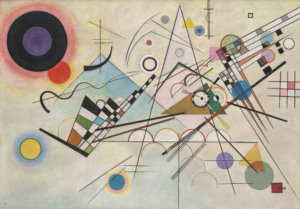
‘Composition 8’ July 1923, oil on canvas, 140.3 x 200.7 cm, Solomon R. Guggenheim Museum, New York, Solomon R. Guggenheim Founding Collection, by gift, photo courtesy Solomon R. Guggenheim Foundation
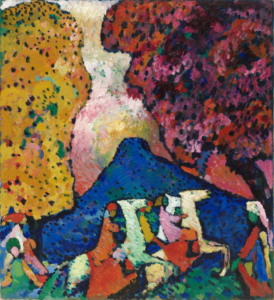
‘Blue mountain’ 1908-09, oil on canvas, 107.3 x 97.6 cm, Solomon R. Guggenheim Museum, New York, Solomon R. Guggenheim Founding Collection, by gift, photo courtesy Solomon R. Guggenheim Foundation
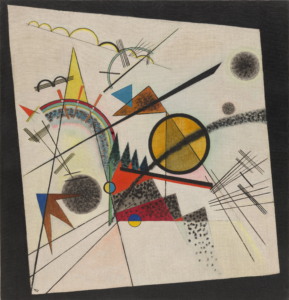
Vasily Kandinsky ‘In the black square’ June 1923, oil on canvas, 97.5 x 93.3 cm, Solomon R. Guggenheim Museum, New York, Solomon R. Guggenheim Founding Collection, by gift, photo courtesy Solomon R. Guggenheim Foundation
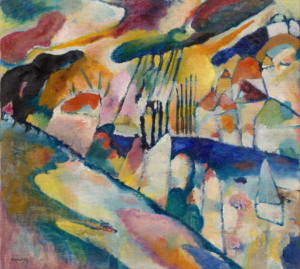
‘Landscape with rain’ January 1913, oil on canvas, 70.5 x 78.4 cm, Solomon R. Guggenheim Museum, New York, Solomon R. Guggenheim Founding Collection, photo courtesy Solomon R. Guggenheim Foundation
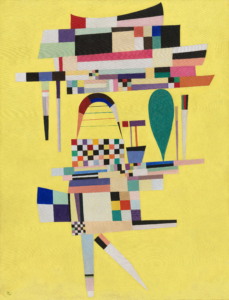
‘Yellow painting’ July 1938, oil and enamel on canvas, 116.4 x 88.9 cm, Solomon R. Guggenheim Museum, New York, Solomon R. Guggenheim Founding Collection, photo courtesy Solomon R. Guggenheim Foundation
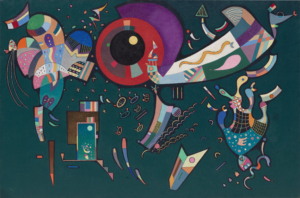
‘Around the circle’ MayAugust 1940, oil and enamel on canvas, 97.2 x 146.4 cm, Solomon R. Guggenheim Museum, New York, Solomon R. Guggenheim Founding Collection, photo courtesy Solomon R. Guggenheim Foundation
5 November 2023, 11:22 pm - 51 minutes 43 secondsEp 151: James Powditch live at the AGNSW
This episode is a conversation between James Powditch and Maria Stoljar in front of an audience at the Art Gallery of NSW, recorded by the Art Gallery Society
James Powditch has always loved the movies. As a child in the 70s and 80s he would watch whatever he could get away with – from Taxi Driver to Deliverance.
But in recent years, after being shortlisted in the Archibald prize with paintings of Labor leader (now PM) Anthony Albanese and journalists Kerry O’Brien and Laura Tingle he noticed other themes emerge; media and politics.
In his most recent solo show at Nanda Hobbs Gallery he found a way to merge those interests. In Medium Cool: Journalism in Film, works took on titles of films in which journalism and politics were central themes. Beautifully composed assemblages incorporating found objects explored the ideas behind movies such as All the President’s men and Network.
James has exhibited in over 10 solo shows and has won the Mosman and Blake art prizes. He has been a finalist in the Archibald Wynne and Sulman prizes for a combined total of about 25 times.
In this episode Maria has a vibrant (and often humorous) conversation with James in front of an audience at the Art Gallery of NSW as part of the Artists in Conversation series.
You can see images of the works they talk about below. Members of the Art Gallery Society can also see a video of this conversation for a limited period on the Art Gallery website.
To hear the podcast conversation press ‘play’ beneath the above photo.
Links
- James Powditch on Instagram
- James Powditch at Nanda\Hobbs Gallery
- Video of this interview on the AGNSW website (for members)
- Art Gallery Society membership page
- Get tickets for the Steve Lopes talk at the AGNSW
- Samantha Dennison interview on the Talking with Painters YouTube channel
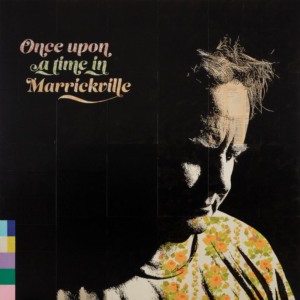
‘Once upon a time in Marrickville – Anthony Albanese’, acrylic on paper and board 190 x 190 cm Finalist Archibald Prize 2020
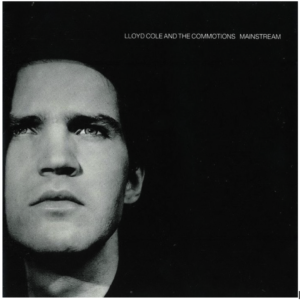
Lloyd Cole and the Commotions album cover
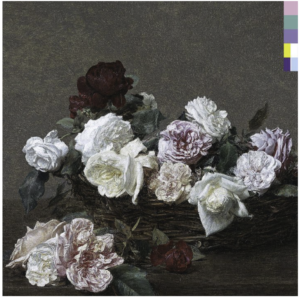
New Order – Power, Corruption and Lies album cover
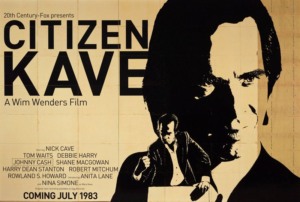
‘Citizen Kave’ mixed media 200 x 300 cm, Finalist Archibald Prize 2014
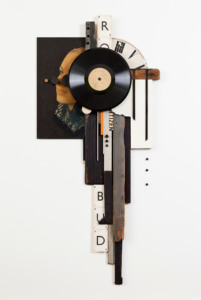
‘Citizen Kane’ 2022 Mixed media, framed 80 x 120cm
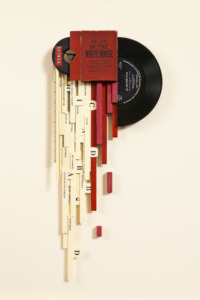
‘All the President’s men II’ 2023 mixed media, 40 x 60cm
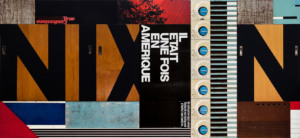
‘All the President’s men’ 2023, mixed media 130 x 282cm
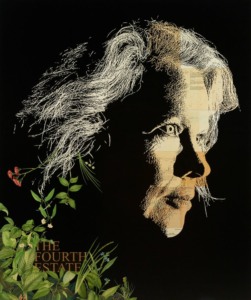
‘Laura Tingle – the fourth estate’ Acrylic and paper on board 204 x 170.1cm Finalist Archibald Prize 2022
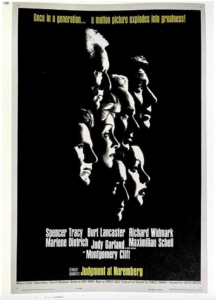
Movie poster ‘Judgment at Nuremberg’
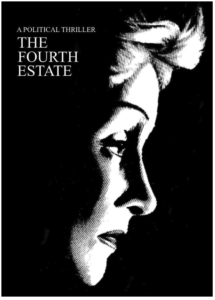
Digital work, James Powditch
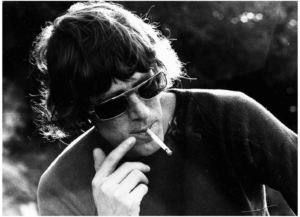
Peter Powditch Photograph by Robert Walker (c1970)
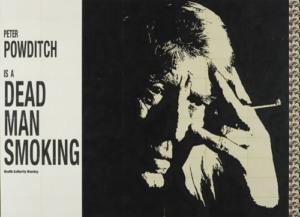
‘Peter Powditch is a dead man smoking’ 2009, Mixed media 193 x 263cm, Finalist Archibald Prize
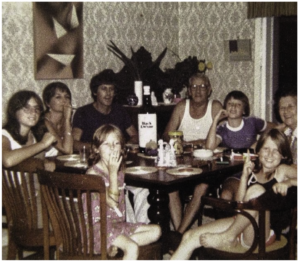
Family photo, James Powditch
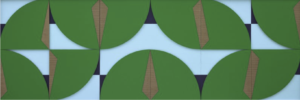
‘Crowdy Head (after Peter Powditch)’, acrylic on paper and cardboard 122 x 366
Finalist Wynne Prize 2022
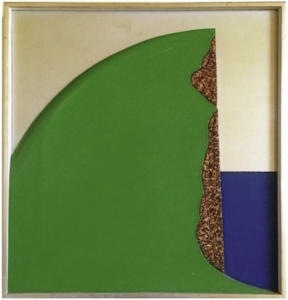
‘Crowdy Head IV’, Oil on masonite, 50 x 48cm, Peter Powditch
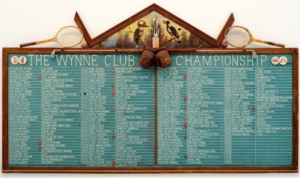
The Wynne Club Championship 2023, oil, acrylic and pen on board, found objects , 180 x 316.1 cm , Wynne Prize finalist
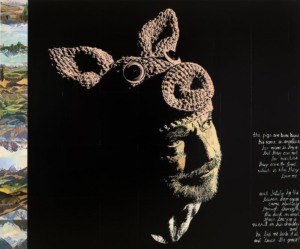
Sam I Am, acrylic on paper and board 200 x 240 cm, Finalist Archibald Prize 2023
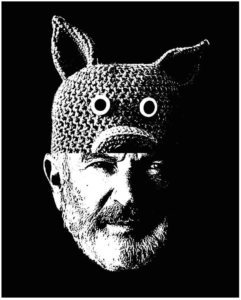
Digital work, James Powditch
21 October 2023, 12:59 am - 24 minutes 24 secondsInspiration from the Archives | Risk
Risk. Some painters want it in their toolbox while others are terrified by it. But nearly every painter will tell you that you need it in order to move forward in your practice.
It might be using a new material, drastically altering the composition of a nearly completed painting or creating a completely different body of work to what had previously been commercially successful and critically acclaimed. Any way you look at it, you’re leaving yourself open to the possibility of failure, disappointment and probably the most painful of all – ridicule.
So whether we call it risk, chance, letting go of control or just leaving yourself open to mistakes, it all amounts to a greater openness to creativity. Taking the leap and seeing what happens.
In this episode I bring together clips from eight previous guests about what risk means to them – and how they use it.
See below for a list of the artists together with links to the full podcast conversation and YouTube video
Press ‘play’ beneath the above image to listen
- Vanessa Stockard Podcast | YouTube
- Paul Ryan Podcast | YouTube
- Guy Warren Podcast | YouTube
- Julian Meagher Podcast | YouTube
- Ken Done Podcast | YouTube
- Juliet Holmes a Court Podcast | YouTube
- Tim Maguire Podcast | YouTube
- Joe Furlonger Podcast | YouTube
Watch the Idris Murphy YouTube Video
Listen to the full Idris Murphy podcast interview
Book tickets for my conversation with Steve Lopes at the Art Gallery of NSW
7 October 2023, 4:04 am - 35 minutes 17 secondsInspiration from the Archives | Colour (Part 2)
More inspiration from the archives!
Here are another 12 past podcast guests talking with me about colour.
Links to full podcast conversations and YouTube videos on each of the artists in this episode:
- 2:13 David Griggs – Podcast | YouTube
- 5:00 Laura Jones – Podcast | YouTube
- 9:08 Lewis Miller – Podcast | YouTube
- 11:10 Lucy Culliton – Podcast | YouTube
- 13:13 Robin Eley – Podcast | YouTube
- 18: 25 Melinda Harper – Podcast | YouTube
- 20:35 Tim Storrier – Podcast | YouTube
- 22:35. Wendy Sharpe – Podcast | YouTube
- 25:28 Idris Murphy – Podcast | YouTube
- 28:22 Aida Tomescu – Podcast | YouTube
- 29:31 Bernard Ollis – Podcast | YouTube
- 31:19 Emily Imeson – Podcast | YouTube
Sign up to the TWP monthly newsletter here
Follow the show on Instagram
Follow the show on Facebook
Connect with me on LinkedIn
10 September 2023, 12:39 pm - 20 minutes 36 secondsInspiration from the Archives | Colour (Part 1)
This episode I’m bringing you some gems from the archives. Leading artists talk with me about colour!
Episodes of featured artists:
Links
- YouTube channel
- Talking with Painters website
- Sign up to the TWP newsletter
- Nicholas Harding talks with me about his Wynne prize painting
- John Wolseley talks with me about his watercolour techniques
- Short Instagram video of Paul Newton talking about flesh tones (longer YouTube video coming soon)
22 August 2023, 7:04 am - 25 minutes 26 secondsEp 147: Ann Thomson in her 90th year
Watch an edited version of this conversation (4 mins) on the YouTube channel here
Ann Thomson, one of Australia’s most important artists, might be in her 90th year but she shows no signs of putting down the brush.
A powerful collection of works is currently hanging in a solo show at Sydney’s Defiance Gallery and Ann is looking forward to a busy 2024. A major survey show to be curated by Terence Maloon will open at the S.H.Ervin Gallery in Sydney and travel to Orange Regional Art gallery in country NSW and solo shows at Messums in London and with Stephane Jacob in Paris are also in the calendar.
Although Ann resists the label ‘abstract artist’, it’s her masterful use of colour and her superb mark making that will most likely catch your attention – those luscious brushstrokes and drips. But subjects often emerge; a landscape, tribal elements, creatures of the ocean.
You’ll also see collaged passages. Ann is well known for using a textured ‘tarred paper’ which was used by builders. Although it’s in scarce supply (she believes she has bought up all remaining rolls in existence!) she doesn’t treat the material as a precious commodity. If you look closely at ‘Calypso’ for example, you’ll see the section of collaged paper is splattered with drips of paint. That’s because it had previously been lying on the floor of Ann’s studio like a drop sheet. She later pasted the paper onto the canvas where it exists surrounded by bright colours, its own history intact.
It was wonderful to catch up with Ann to hear her thoughts on creativity and studio life. She has been a guest on the podcast twice previously – in 2018 talking about her life and art and in 2020 talking about her memories of meeting Ian Fairweather (links below).
Ann is represented by Defiance Gallery in Sydney, Mitchell Fine Art in Brisbane, Charles Nodrum Gallery in Melbourne, Messums in London and Stephane Jacob in Paris.
To hear our conversation press ‘play’ beneath the above photo and scroll down for images of selected works included in the show.
Latest Talking with Painters YouTube videos
Other links
- 2018 Podcast conversation with Ann Thomson
- 2018 YouTube video in Ann Thomson’s studio
- Podcast conversation with Ann Thomson on Ian Fairweather
- Podcast conversation with Claire Roberts on Ian Fairweather
- Ann Thomson’s website
- Article on Artsy Website: 9 Overlooked Women Artists in Their Nineties
https://youtu.be/qLf00VQ3U6E
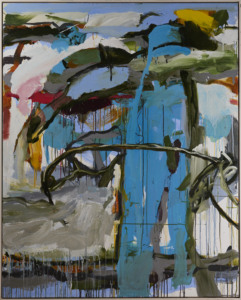
Transcending 2018
Acrylic on linen
153 x 122.5 cm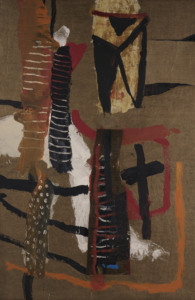
Shield, 2023
acrylic on tarred paper on canvas
120.5 x 81 cmThis is one of the two works referred to at about 4mins in the episode.
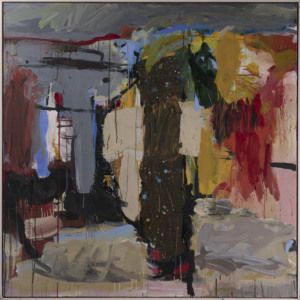
Calypso, 2013
oil on linen
122 x 122cm9 August 2023, 9:19 am - More Episodes? Get the App
Your feedback is valuable to us. Should you encounter any bugs, glitches, lack of functionality or other problems, please email us on [email protected] or join Moon.FM Telegram Group where you can talk directly to the dev team who are happy to answer any queries.
 Plein Air Art Podcast
Plein Air Art Podcast
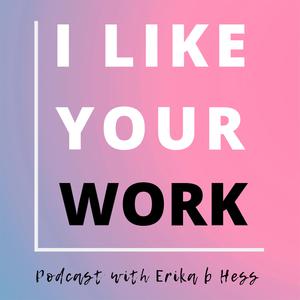 I Like Your Work: Conversations with Artists, Curators & Collectors
I Like Your Work: Conversations with Artists, Curators & Collectors
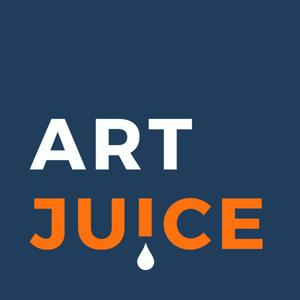 Art Juice: A podcast for artists, creatives and art lovers
Art Juice: A podcast for artists, creatives and art lovers
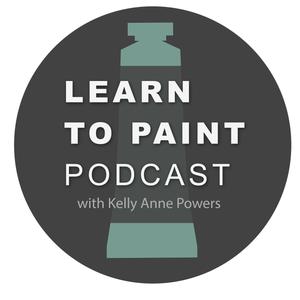 Learn to Paint Podcast
Learn to Paint Podcast
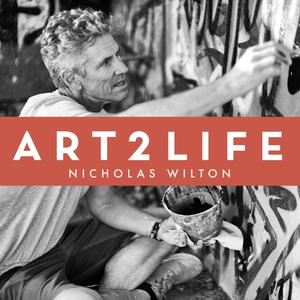 Art2Life
Art2Life
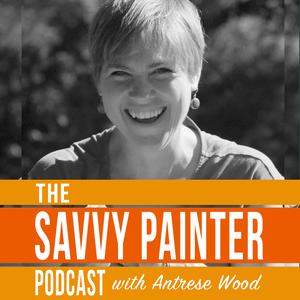 Savvy Painter Podcast with Antrese Wood
Savvy Painter Podcast with Antrese Wood